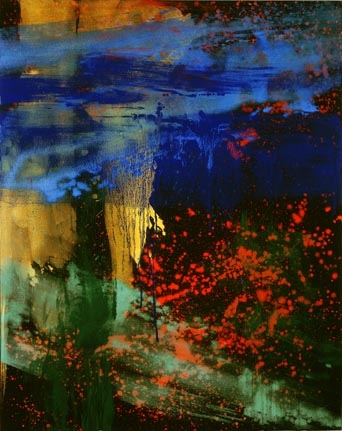On 9-11 artist Makoto Fujimura had to evacuate his home and studio located a scarce three blocks from the smoking rubble of the World Trade Center. When he was allowed to return he opened his studio doors to be a place of community, consolation and healing for local “ground zero” artists.
On Wednesday, Nov 4th you are invited to an Evening Conversation with Makoto Fujimura at the Columbia Museum of Art. Free admission. Reservation required. Presented by The Trinity Forum. Details here.
Just weeks after severe flooding, in the midst of our rebuilding, Mako will speak in Columbia, SC. Out of his post-9-11 conversations Mako brings a timely and timeless message of hope: “In the midst of fear, in the midst of material and emotional scarcity, in the midst of the world’s collapsing idols, we can draw on the Giver / Artist, and let His creative Spirit spill over into a hurting world.”
Mako’s work has been exhibited in museums and galleries around the world. From 2003-2009 he served as a Presidential appointee to the National Council on the Arts.
Schooled in the ancient Japanese art of “Nihonga,” he creates his paints out of ground minerals and applies them on the canvass in layers of translucent washes. The richness of ground malachite, lapiz, vermillian as well as gold and silver, both in powder and foil, offer tribute to the richness of his subjects.
In this painting, Charis Kairos: The Tears of Christ, Mako begins with a black background representing the sorrow and brokenness of existence. Two large pillared washes of gold and sprinkles of vermillion evoke the splendor of the presence of God and the shed blood of his Son.
Across the entire width of the canvas the azurite-washed tears of Christ flow and spill down into the black and, with generative power, the green malachite wash below. Here “love and sorrow meet,” sacrificial blood is spilled and new life grows.
Reflecting on this work, Mako writes,
May we be deeply aware that Christ’s tears shed two millennia ago are still powerfully present in this world, as the medium of hope and new creation.
Mako encourages us to bear witness to that hope by creating living art out of love in the form of kindnesses, whether friendship, food, hospitality, music, dance, painting, flower-arranging, whatever our gifts. “Spiritual, emotional and material generosity is surprising in an age of perceived scarcity; therefore, we can rise to the occasion. We create art not as a commodity, but as a gift. Just as the Gospel is not a commodity, but a Gift.”
The finest Art is first a gift of transcendence—inviting us to stand outside ourselves and gain perspective. As we create and give to others we invite them to gain perspective, to look to the Love, the Giver / Artist behind our gift.
Mako has created a wondrous gift out of the Gift of the gospel. To commemorate the 400th anniversary of the King James Bible published in 1611, Crossway, publishers of the English Standard Version Bible, commissioned Mako to produce The Four Holy Gospels, the first illuminated manuscript since Robert Blake’s in the late 18th/early 19th century.
A year and a half in the making, with illumined letters at the beginning of each chapter, hand-embellished drawings on most pages and full-page reproductions of his paintings representing the four gospel evangelists, it feels like a contemporary Book of Kells.
On the page where Jesus heals the man at the pool of Bethesda Mako entertwines his lavish colors into a graceful double helix of DNA, startling the reader into considering the anatomical repercussions of that miraculous moment.
Below the story of the Garasene demoniac broken shackles tinged with red, then black, then blue evoke the demoniac’s battle with the Legion of evil and the washing of Jesus’ healing. The shackles finally dissolve into ribbons of red. The bondage to sorrow, rage, nakedness, cutting and misery is broken by the blood of a Savior who loves and redeems.
The large 11” x 16” volume fills my entire lap, harkening back to the large preaching Bibles published in multiple volumes to help pastors see their texts in dimly lit pulpits. Turning the pages my fingers slide across the glossy, high quality art-paper rimmed with gold. The large 13-point font facilitates a seamless experience of reading, looking away to meditate and reading again.
Taken together, the beauty of the deep-earth colors, the hand-embellishments, and the rich Belgian linen cover and art-paper pages invite me in to a more transcendent experience of reading God’s Word—very different from reading pixels on a screen surrounded by little software operating icons. God can meet us in a cathedral or a store front. But as my son said when he walked in Saint Paul’s cathedral in London, in such a sacred, art-drenched space, “You can’t help but think, God is God and you are not.”
The video above shows Mako creating his extraordinary canvasses, illuminating the gospel pages. He concludes it saying, “We today have a language to celebrate waywardness. But we don’t have a cultural language to bring people back home. And so everything I do—my paintings, my work—has something to do with that. I hope this project will be enduring.”
Related post: Fall pastels, Ugly Runway Models and the Battle for Beauty
Related post: Why the Gospel is better than the world of Norman Rockwell


Please note: I reserve the right to delete comments that are offensive or off-topic.